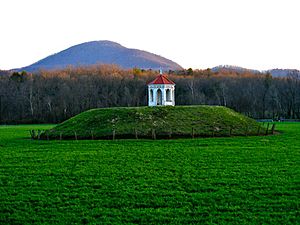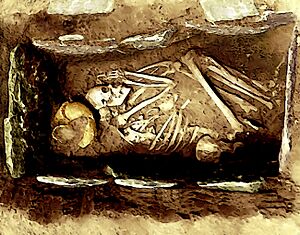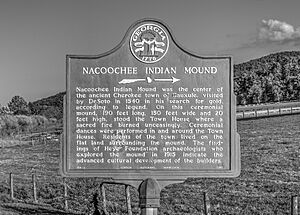Nacoochee Mound facts for kids

The Nacoochee Mound
|
|
| Location | Helen, Georgia, White County, Georgia, |
|---|---|
| Region | White County, Georgia |
| Coordinates | 34°41′01″N 83°42′32″W / 34.68351°N 83.709°W |
| History | |
| Founded | 100 BCE |
| Abandoned | 1600 CE |
| Periods | Early Middle Woodland, Lamar Phase |
| Cultures | South Appalachian Mississippian culture |
| Site notes | |
| Excavation dates | 1915, 2004 |
| Archaeologists | Frederick Webb Hodge, George H. Pepper |
| Architecture | |
| Architectural styles | platform mound |
| Architectural details | Number of temples: 1 |
|
Sautee Valley Historic District
|
|
| NRHP reference No. | 86002742 |
| Added to NRHP | August 20, 1986 |
The Nacoochee Mound is an archaeological site in White County, Georgia. It sits right by the Chattahoochee River. This special place tells us a lot about ancient people.
People first lived here around 100 to 500 CE. Later, from 1350 to 1600 CE, the South Appalachian Mississippian culture lived here. They built a large platform mound, which is a raised flat area. Archaeologists also found signs of villages nearby.
In 1890, a gazebo was built on top of the mound. After the mound was dug up, a former governor had a copy of it built. This copy is south of Helen, Georgia.
Some people believe the historic Cherokee tribe lived here. A historical marker at the site mentions this. However, more digging is needed to confirm this for sure. The Nacoochee Mound is part of the Sautee Valley Historic District. It became a protected site on August 20, 1986.
Contents
Exploring the Nacoochee Mound

In the 1870s, Captain John H. Nichols owned the mound land. He found stone box graves while plowing. These graves are from the Mississippian culture. In 1873, the mound was described as 16 feet (4.9 m) tall. In 1890, Captain Nichols removed the top 2 feet (0.61 m) and built a gazebo. This gazebo became a local landmark.
Digging Up the Past
The Nacoochee Mound was officially dug up in 1915. A team of archaeologists led by Frederick Webb Hodge and George H. Pepper did the work. This was one of the first scientific digs in Georgia. They were sponsored by the Heye Foundation, the Museum of the American Indian, and the Smithsonian Institution.
In 1918, they published a book about their findings. The dig uncovered 75 human burials. These included adults, teenagers, and children. Some bodies were too old to tell their age.
The burials were in layers, showing different time periods. About a third of the people were buried with special items. These items showed their social status. They found hammered copper tools and stone celts. They also found conch shell beads and cups. Beautiful Mississippian pottery was also discovered.
Some later burials had glass beads and brass ornaments. This means these burials were from the 1600s. This was when Europeans first came to the area.
What We Learned from the Digs
More test digs happened in 2004 by the University of Georgia. These digs helped scientists learn more about when people lived there. The mound was used during the Early Middle Woodland period. It was most used during the Mississippian period, from 1350 to 1600 CE. This was during a time called the Lamar Phase.
Archaeologists found pottery pieces similar to those at the Etowah Indian Mounds site. This shows that both sites were used around the same time. A small village was found east of the mound. A much larger village was found to the west.
The Nacoochee Mound and a nearby site, the Eastwood Site, were important places. They likely served as centers for nearby villages in the late 1400s and early 1500s.
The Cherokee Connection
Old maps from 1715 show Cherokee towns named Nacoochee and Chota in this valley. This mound site might have been one of those villages. However, the Cherokee left both Nacoochee and Chota towns after the mid-1700s.
A bronze historical marker from 1955 is at the site. It says that, according to legend, this is the "ancient Cherokee town of Gauxule." It also says Hernando de Soto visited it in 1540. While De Soto explored the area, scholars are still figuring out his exact path. Early stories about his travels were not always accurate.
The original Nacoochee Mound was partly dug up. Former Georgia governor Lamartine Griffin Hardman had a copy of this mound built. It is on his land in the Nacoochee Valley, two miles south of Helen. This copy still stands today.




